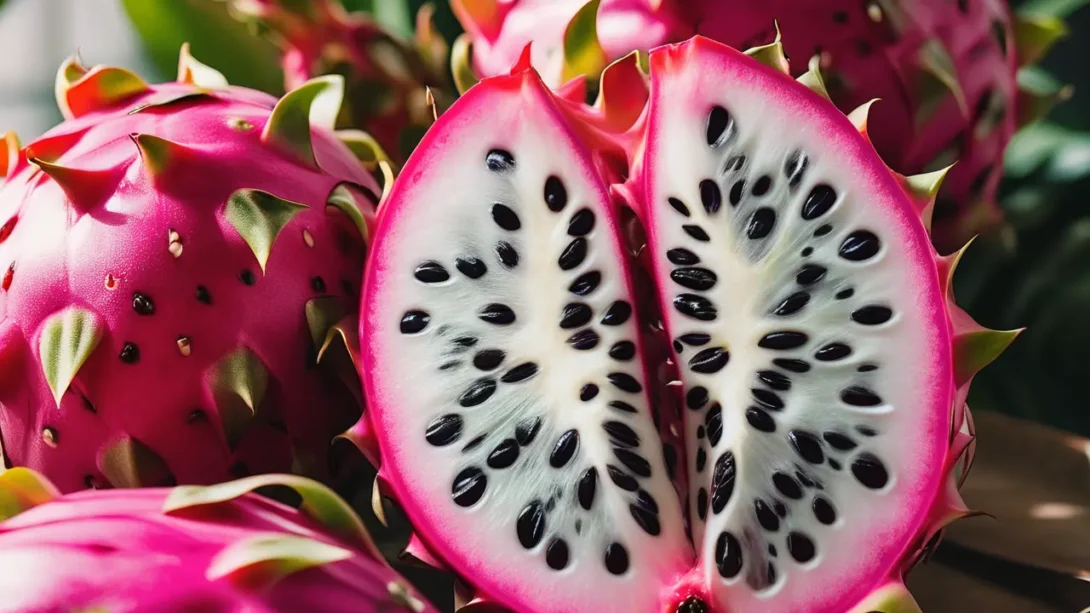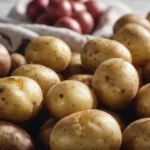Dragon fruit, also known as pitaya, is a captivating tropical fruit celebrated for its vibrant hues and unique appearance. As one of the most visually striking fruits in the world, dragon fruit has captured the imagination of food enthusiasts and health-conscious individuals alike. Central to its allure is the dazzling array of colors that adorn its flesh, ranging from radiant reds to ethereal whites and sunny yellows.
Dragon Fruit
Before we delve into the kaleidoscope of colors exhibited by dragon fruit, it’s essential to acquaint ourselves with this extraordinary fruit. Dragon fruit belongs to the genus Hylocereus and Selenicereus, with the most commonly cultivated varieties being Hylocereus costaricensis (red dragon fruit), Hylocereus undatus (white dragon fruit), and Selenicereus megalanthus (yellow dragon fruit). Native to Central and South America, dragon fruit is now grown in tropical regions worldwide, thriving in warm climates with well-draining soil.
Dragon fruit’s allure extends beyond its visual appeal; it is also prized for its nutritional richness. Rich in antioxidants, vitamins, and minerals, dragon fruit offers a host of health benefits, including improved immune function, digestion, and skin health. Its subtle sweetness and refreshing texture make it a popular ingredient in smoothies, salads, desserts, and exotic culinary creations.
The Natural Color Spectrum of Dragon Fruit
Now, let’s embark on a journey to explore the captivating colors of dragon fruit:
1. Red Dragon Fruit (Hylocereus costaricensis)
- Characterized by its vibrant pink to deep red flesh, the red dragon fruit is a feast for the eyes. The intensity of its coloration varies depending on factors such as variety, ripeness, and growing conditions.
- Rich in antioxidants such as betalains and anthocyanins, red dragon fruit not only delights the senses but also offers potential health benefits, including anti-inflammatory and heart-protective properties.
- In culinary applications, red dragon fruit adds a dramatic flair to dishes, imparting both visual appeal and a subtly sweet flavor profile reminiscent of kiwi or pear.
2. White Dragon Fruit (Hylocereus undatus)
- In stark contrast to its red counterpart, the white dragon fruit boasts a pristine white flesh punctuated by tiny black seeds. Its understated elegance and delicate flavor profile make it a sought-after delicacy.
- Despite its lack of pigmentation, white dragon fruit is packed with nutrients, including vitamin C, fiber, and antioxidants. Its mild, slightly sweet taste with hints of floral notes makes it a versatile ingredient in both sweet and savory dishes.
- White dragon fruit’s neutral hue serves as a canvas for culinary creativity, lending itself beautifully to smoothie bowls, fruit salads, and exotic desserts.
3. Yellow Dragon Fruit (Selenicereus megalanthus)
- Embodied by its radiant yellow flesh adorned with jet-black seeds, the yellow dragon fruit exudes tropical charm and vibrant energy. Originating from South America, this variety offers a delightful sensory experience.
- Yellow dragon fruit is renowned for its juicy texture and tangy-sweet flavor profile, reminiscent of a blend between pineapple and citrus fruits. Its high vitamin C content and antioxidant properties contribute to its appeal as a healthful treat.
- Culinary enthusiasts and mixologists alike cherish the yellow dragon fruit for its ability to infuse beverages, cocktails, and tropical fruit salads with its sunshine-hued essence, evoking visions of paradise.
Factors Influencing Dragon Fruit Coloration
The captivating colors exhibited by dragon fruit are influenced by a myriad of factors, including genetics, ripeness, and environmental conditions:
- Genetic Variability: Different varieties of dragon fruit possess distinct genetic traits that influence their coloration. While some varieties naturally exhibit vibrant hues, others may showcase more subdued or pastel tones.
- Ripeness and Maturity: The stage of ripeness plays a significant role in determining the color intensity of dragon fruit. As the fruit ripens, it undergoes biochemical changes that can enhance or diminish its coloration.
- Environmental Factors: Environmental conditions such as temperature, light exposure, and soil composition can impact the development of pigments in dragon fruit. Variations in these factors can result in subtle differences in coloration among fruits grown in different regions.
Culinary and Aesthetic Applications of Dragon Fruit Colors
Beyond their visual allure, the diverse colors of dragon fruit lend themselves to a myriad of culinary and aesthetic applications:
- Visual Appeal in Culinary Presentations: The vibrant hues of dragon fruit make it a prized ingredient for enhancing the visual appeal of culinary creations. From fruit platters and salads to smoothie bowls and desserts, dragon fruit adds a pop of color and an element of sophistication to any dish.
- Nutritional Diversity and Health Benefits Across Varieties: Each variety of dragon fruit offers its own unique blend of nutrients and health benefits. Whether you’re enjoying the antioxidant-rich red dragon fruit, the fiber-packed white dragon fruit, or the vitamin C-loaded yellow dragon fruit, you can rest assured that you’re indulging in a nutritious treat that nourishes both body and soul.
- Market Demand and Consumer Preferences: As consumers become increasingly health-conscious and adventurous in their culinary pursuits, the demand for exotic fruits like dragon fruit continues to rise. The vibrant colors and enticing flavors of dragon fruit appeal to a wide range of palates, making it a popular choice among health enthusiasts, foodies, and chefs alike.
Cultivation and Harvesting Practices for Optimal Color Development
To ensure the vibrant colors of dragon fruit are fully realized, growers must employ proper cultivation and harvesting practices:
- Best Practices for Growing Dragon Fruit: Providing dragon fruit plants with adequate sunlight, well-draining soil, and proper irrigation is essential for optimal growth and color development. Additionally, maintaining balanced nutrient levels and protecting plants from pests and diseases can help ensure healthy fruit production.
- Harvesting Techniques to Preserve Color and Quality: Harvesting dragon fruit at the peak of ripeness is crucial for preserving its vibrant colors and flavor. Fruits should be carefully handpicked to avoid bruising or damage, and harvested during cooler periods of the day to minimize stress on the plants.
- Post-Harvest Handling and Storage Considerations: After harvesting, dragon fruit should be handled with care to prevent damage to the delicate skin and flesh. Proper storage conditions, including cool temperatures and adequate ventilation, can help prolong the shelf life and quality of the fruit.
The Future of Dragon Fruit Color Research
As interest in dragon fruit continues to grow, so too does the potential for further research and innovation in color enhancement and preservation techniques:
- Emerging Trends in Dragon Fruit Cultivation and Breeding: Advances in agricultural science and biotechnology hold promise for the development of new dragon fruit varieties with enhanced color, flavor, and nutritional profiles.
- Innovations in Color Enhancement and Preservation Techniques: Researchers are exploring novel methods for enhancing and preserving the vibrant colors of dragon fruit, including natural pigments and post-harvest treatments.
- Opportunities for Sustainable Production and Market Expansion: With increasing demand for exotic fruits in global markets, there are opportunities for sustainable production practices and market expansion that can benefit both growers and consumers.
In conclusion, the vivid palette of colors exhibited by dragon fruit is a testament to the beauty and diversity of nature. Whether enjoyed for its visual appeal, nutritional richness, or culinary versatility, dragon fruit continues to captivate hearts and palates around the world. As we continue to unlock the secrets of this remarkable fruit, the future looks brighter than ever for dragon fruit enthusiasts everywhere.




